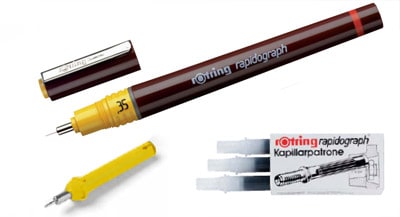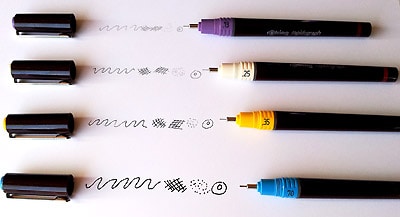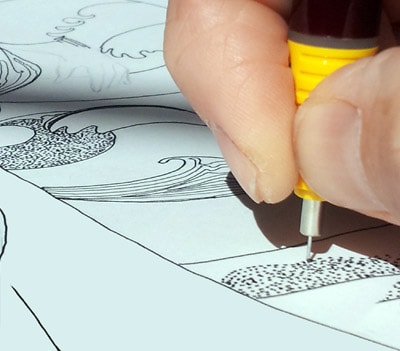Technical drawing pens were originally developed for architects and engineers (for precision and all that jazz to do with rulers, compasses and drawing straight predictable lines), though today they are mainly used by artists, draughtsmen and comic artists, who have fallen in love with the lure of permanent black ink and the blissfully predictable lines achievable with these pens.
Deciding to finally get a set, I went on a research journey, which took me through a maze of pen addict forums, suppliers, reviewers and a few shady, cross-hatched and stippled places… all providing plenty of information about pen types, how they work and what various people think of them. Summing up: rOtring make really good pens, Faber Castell (TG1-S) and Staedtler (Mars Matic) also make good pens – Koh-I-Noor, while a recognised brand in the US, appear to have clogging and other not-so-great issues (so I quickly dropped them from the list).
I decided to go with rOtring, yet (like in all good stories) discovered one last hurdle: rOtring offer two different types of technical pens: The rOtring Rapidograph, which uses cartridges – and the rOtring Isograph, which you refill from an ink bottle…
I ended up buying the Rapidograph (cartridge version) from the lovely people at Cult Pens, upon reaching the conclusion that I am way too messy and impatient to refill pens from a bottle. Added to that; part of the joy with a great pen, is that it is ready when I am… the thought of having to clean it, fill it and pat it on the head before we get started is cute, but a little inspiration-stalling…

The parcel arrived yesterday and I almost hugged the postman :)
I love the way the top part of the pens are colour coded (makes it so much easier to find the right pen…)
The image above shows the line-widths of each pen – the finest one (purple) is only 0.13 mm and a lovely pen to draw very fine lines with, the thickest one (blue) is 0.7 mm and perfect for darker thicker line-work.
One of the main points to make about these pens (any fine drawing pens really), is that you should keep the pen close to up-right while drawing (i.e. not on a sloping angle as you perhaps would when writing a fancy letter). The reasons for this are:
- Holding the pen in the up-right position, means that the ink flows better because of the mechanism inside the actual nib.
- You avoid damaging the nib (especially on the finer sizes)
While these are my first technical pens, having used plenty of steel-nibbed drawing pens, meant that the drawing angle was not a problem :)
I quickly embarked on my ‘first’ drawing – the first few lines felt a little shaky (excitement no doubt), but very soon the pens felt simply fantastic! It’s a little like getting used to a new car where you’re working out things, like how fast you can go around a bend before it all gets a little hairy ;) With these pens it’s more about how fast can I draw a line before the ink-flow is interrupted…. watching the ink flow… and… relax :). So far, they seem very reliable, and stippling (lots of dots) is much easier with these pens; less hammering on the paper, because the ink is simply just ‘there’ when you need it to be.
I’ll post a few drawings in my next post.
Thank you for visiting!
Annette :)






I used to do technical drawings in highschool using Rotring pens… haven’t used any of those ever since to be honest.
Using Staedtler pigment liners at the moment, which I really like.
Anyway, these look quite promising, perhaps I’ll try them again sooner or later :)
Hi Johan, thanks for popping in to say hello :) – It might be the novelty, but so far I’m really loving the Rotring pens… maybe you’d discover something new about them if you tried them again :) – Weren’t you doing quite technical ballpoint drawings there for a while? Anyway, hope all is good your end :)
It sure is!
My kids are growing up nice and healthy.
I discovered Josh Ritter. Thanks to this guy, I bought a guitar again after not having played for 15 years (the old one I gave away to a young cousin)
I got a raise at work and most importantly, I just noticed our apple trees are starting to blossom so it couldn’t be better :D
how bout you?
Oh good to hear! Sounds like you’re doing great :) Funny, there’s a lot of guitar in our house too – everyone but me is busy playing, and I’m enjoying the entertainment:) I’ll tell kids and Bo to check out Josh Ritter :) – Apple trees in blossom, how idyllic that sounds! We’re heading for winter here, but have been lucky to have a wonderfully sunny and warm autumn, so all is good.
They look fantastic; I can’t wait to see them!
Thank you, and definitely you will! (with the risk of sounding completely neurotic, I’ve even crocheted a bag for them :D ).
Nice article. Looking forward to your next post, I want to see your drwaings
Hi, Thanks for the great post! I’m wondering if you could tell me if the rotring has an even finer point than the Micron 03 (.15) which is the finest pen I could find in the store? I’m looking for an even finer pen for stippling. Thanks and keep up the great content!
Hi Giovanna, thanks for popping in!
I have used the (purple barrel) rotring 0.13 (with limited success ;)) I have seen 0.1 advertised, but even the 0.13 is soooo fine that (for me at least) the nib clogs easily (eventually becoming unusable) – I have stuck with the 0.18 as the finest. If you do have the chance to ‘try before you buy’, you will notice a difference between rotring rapidograph and Micron (how each pen feels, behaves and the way the ink flows) and you may find that 0.18 or even 0.25 is fine enough for stippling. Good luck on your pen finding venture!